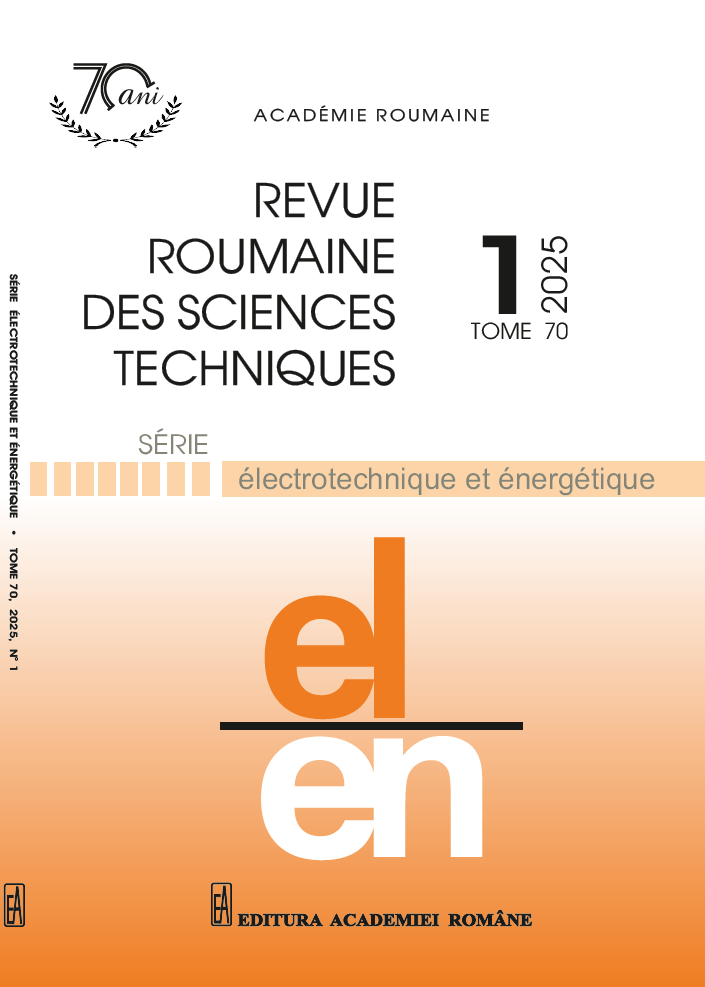CONTRÔLEUR D'ATTITUDE ROBUSTE ET DÉTECTION DE DÉFAUTS DE SATELLITE FLEXIBLE
DOI :
https://doi.org/10.59277/RRST-EE.2025.1.21Mots-clés :
Satellite flexible, Contrôle d'attitude, Défaut additif, Observateur de perturbations, Contrôleur proportionnel-dérivatifRésumé
Pour garantir des opérations satellites flexibles fiables et précises, il est crucial de développer des schémas de contrôle efficaces. Cet article propose un schéma intéressant de contrôleur et d'observateur PD pour un satellite flexible. Plus précisément, un observateur fonctionnel vise à détecter et à atténuer les défaillances des actionneurs, complété par un système de contrôle basé sur la rétroaction de sortie pour compenser efficacement les perturbations et les vibrations du satellite. Le contrôleur améliore la précision du suivi en régime permanent en traitant la dynamique flexible du satellite comme des perturbations. La convergence de l'erreur de suivi et de la stabilité du système en boucle fermée est assurée par l'analyse de Lyapunov. Les performances du schéma de contrôle proposé sont démontrées numériquement, ce qui a révélé des améliorations significatives de la précision du contrôle d'attitude du satellite et de sa stabilité face aux problèmes de vibrations liés aux défaillances des actionneurs.
Références
(1) L. Zhang, S. Xu, Z. Zhang, N. Cui, Active vibration suppression for flexible satellites using a novel component synthesis method, Advances in Space Research, 67, 6, pp. 1968–1980 (2021).
(2) Da Fonseca, M. Ijar et al., Attitude and vibration control of a satellite containing flexible solar arrays by using reaction wheels and piezoelectric transducers as sensors and actuators, Acta Astronautica, 139, pp. 357–366 (2017).
(3) N. Francesco, F. Daniele, G. Michele, et al., Attitude dynamics and control of a large flexible space structure by means of a minimum complexity model, Acta Astronautica, 198, pp. 124–134 (2022).
(4) J.A Breakwell, Optimal feedback slewing of flexible spacecraft, J. Guid. Control, 4, 5, pp.472–479 (1981).
(5) A.E. Bryson, Optimal control – 1950 to 1985, IEEE Control Systems Magazine, 16, 3, pp. 26–33 (1996).
(6) Q.L. Hu, Z.D. Wang, H.J. Gao, Sliding mode and shaped input vibration control of flexible systems, IEEE Trans. Aerosp. Electron. Syst, 44. 2, pp. 503–519 (2008).
(7) Q.L. Hu, Variable structure maneuvering control with time-varying sliding surface and active vibration damping of flexible spacecraft with input saturation, Acta Astronaut., 64, pp .1085–1108 (2009).
(8) B. Xiao, Q.L. Hu, G.F. Ma, Adaptive L-two-gain controller for flexible spacecraft attitude tracking, Control Theory & Applications, 28, pp. 101–107 (2011).
(9) D. Bustan, S.K Sani, N. Pariz, Adaptive fault-tolerant spacecraft attitude control design with transient response control, IEEE Trans. Mechatronic., 19, 4, pp.1404–1411 (2014).
(10) M.Y. Ovchinnikov, S.S. Tkachev, A.I. Shestopyorov, Algorithms of stabilization of a spacecraft with flexible elements, J. of Computer and Systems Sciences International, 58, pp. 474-490 (2019).
(11) G.F. Ma, Y. Jiang, Q.L. Hu, Time delay backstepping based attitude attitude control of satellites, Acta Aeronautica et Astronautica Sinica, 31, 5, pp. 1066–1073 (2011).
(12) I. Ali, G. Radice, J. Kim, Backstepping control design with actuator torque bound for spacecraft attitude maneuver, J. Guid. Control Dyn, 33, 1, pp. 254–259 (2010).
(13) Y. Yu, X. Meng, K. Li, F. Xiong, Robust control of flexible spacecraft during large-angle attitude maneuver, Journal of Guidance, Control, and Dynamics, 37, 3, pp. 1027–1033 (2014).
(14) T. Kida, I. Yamaguchi, Y. Chida, T. Sekiguchi. On-orbit robust control experiment of flexible spacecraft, ETS-VI, J. Guid. Control Dynam., 20, 5, pp. 865–72 (2012).
(15) N. Tomoyuki et al., Design and implementation of robust symmetric attitude controller for ETS-VIII spacecraft, Control Engineering Practice, 18, 12 pp. 1440–1451 (2010).
(16) N.C. Singer, W.P. Seering, Reshaping command inputs to reduce system vibration, pp. 76–82 (1990).
(17) Q. Hu, M. Guangfu, Vibration suppression of flexible spacecraft during attitude maneuvers, J. of Guid., Control, and Dynam., 28, 2, pp. 377–380 (2005).
(18) B.J. Eddine, K. Boulanouar, B. Elhassen, High-precision controller using LMI method for three-axis flexible satellite attitude stabilization, The Aeronautical Journal, pp. 1–12 (2023).
(19) L. Guo, WH. Chen, C.B. Feng, A survey of disturbance-observer based control for dynamic nonlinear systems, Dyn. Cont. Discrete Impulsive Syst. Ser. B, Appl. Algorithms, pp. 79–84 (2006).
(20) W.H. Chen. Nonlinear disturbance observer-enhanced dynamic inversion control of missiles, J. Guid. Control., and Dyn., 26, 1, pp. 161–166 (2003).
(21) B.J. Eddine, K. Boulanouar, Active control design approach for roll/yaw attitude satellite stabilization with flexible vibration, Automatic Control and Computer Sciences, 54, 1, pp. 70–79 (2020).
(22) J.E Benmansour, K. Boulanouare, Attitude stabilization of slosh-coupled satellite with flexible appendage, Algerian Journal of Signals and Systems, 6, 3, pp. 175–180 (2021).
(23) M.N. Hasan, M. Haris, Q. Shiyin, Flexible spacecraft's active fault-tolerant and anti-unwinding attitude control with vibration suppression, Aerospace Science and Technology, 122, pp. 107397 (2022).
(24) M.N. Hasan, M. Haris, Q. Shiyin, Vibration suppression and fault-tolerant attitude control for flexible spacecraft with actuator faults and malalignments. Aerospace Science and Technology, 120, pp. 107290 (2022).
(25) U. Javaid, Z. Zhen, Y. Xue, S Ijaz, Robust adaptive attitude control of flexible spacecraft using a sliding mode disturbance observer. Proceedings of the Institution of Mechanical Engineers, Part G: Journal of Aerospace Engineering, 236, 11, pp. 2235–2253 (2022).
(26) J.R. Wertz, Space Mission Analysis and Design; Space Technology Library, Kluwer Academic Publishers, Dordrecht, Boston, London: Springer (1991).
(27) J.E. Benmansour, B. Khouane, Feed-forward control design for roll/yaw attitude flexible spacecraft based on the disturbance observer, Rev. Roum. Sci. Techn. – Électrotechn. Et Énerg., 67, 2, pp. 187–191 (2022).
(28) K. Lu, Y. Xia, Z. Zhu, M.V. Basin, Sliding mode attitude tracking of rigid spacecraft with disturbances, Journal of the Franklin Institute, 349, pp. 413–440, (2012).
(29) S. Boulouma, S. Labiod, H. Boubertakh, Direct adaptive control of a flexible spacecraft with disturbances and uncertain actuator failures, Mechanical Systems and Signal Processing, 110, pp. 73–89 (2018).
Téléchargements
Publiée
Numéro
Rubrique
Licence
(c) Copyright REVUE ROUMAINE DES SCIENCES TECHNIQUES — SÉRIE ÉLECTROTECHNIQUE ET ÉNERGÉTIQUE 2025

Ce travail est disponible sous licence Creative Commons Attribution - Pas d'Utilisation Commerciale - Pas de Modification 4.0 International.


